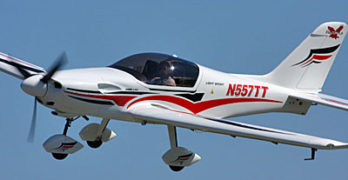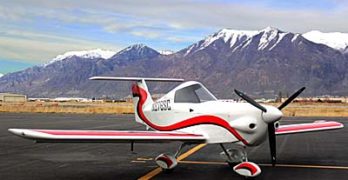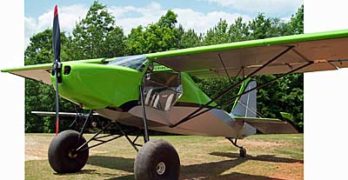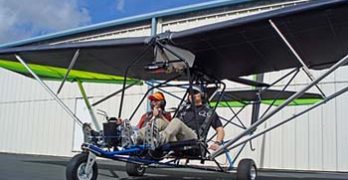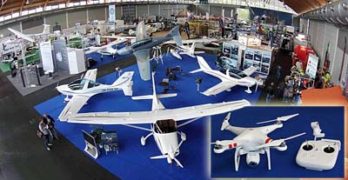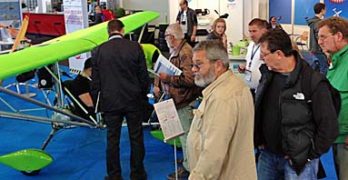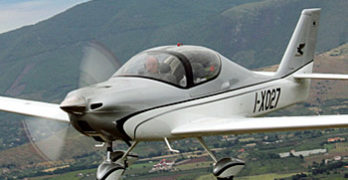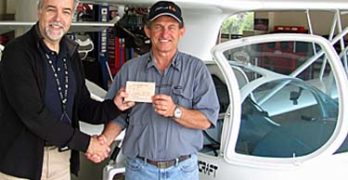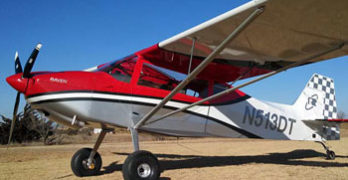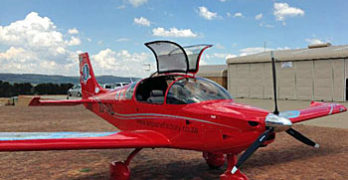For 18 months, we haven’t seen much of a sleek low-wing airplane called the Falcon LS. Even its name was challenged by French bizjet maker, Dassault Falcon, because … well, you know, someone might be confused. However, Renegade Light Sport Aircraft operator Doc’ Bailey is not an idle man waiting for the weeds to grow between his toes. He’s been busy creating his SPAR race circuit and — even though he had to relocate again after moving from Missouri to Florida (he’s now happily quartered at the sport aviation-friendly Deland airport) — Doc’ has been quietly plugging away on his Falcon line. He’s also kept his spare time to a minimum representing the D-motor video and the B.O.T. Super Cruiser, while simultaneously creating his Lil’ Rascal version of the Pitts S1 biplane. OK, so he’s busy but what about Falcon?
VX Aerospace is an advanced composites company near the Appalachian Mountains in Morganton, North Carolina.
SkyCraft Completes Flight Testing of Minisport LSA
“After a long winter and spring dodging the Utah weather,” SkyCraft Airplanes announced that their SD-1 Minisport, “has completed flight testing successfully, meeting all the performance requirements needed for SLSA Certification.” The Orem, Utah company reported, “The plane was found to have good longitudinal and latitudinal stability and exhibited no issues with flutter, vibrations, or dangerous stall/spin tendencies.” SkyCraft representatives said they were able to verify the performance specifications for the SD-1 achieved by its Czech designers (see video below for a performance hint using a European aircraft). SkyCraft said that following the flight test regimen, they posted updated specifications on the Minisport page.
Minisport has been flying in Europe since 2007 when the airplane and company were created by designer Igor Spacek. The U.S. team first contemplated a kit aircraft — SD-1 Minisport is constructed significantly of wood making it a great project for some craftsmen — but later elected to go the fully-built Special LSA route.
Just on Fire! SuperSTOL Leads to 500th Kit
We all have favorites … foods, websites, movies, and of course, airplanes. I have favorites, too. This doesn’t mean my favorites are better than others, nor that anyone else may agree with me. That’s OK. Properly caveated, I have to say one of my favorite airplanes is Just Aircraft’s SuperSTOL. Flying it at last Sun ‘n Fun with head developer Troy Woodland was arguably my most enjoyable flying experience at the show, or for that matter, in recent memory. To state this carefully, airplanes have different capabilities so I don’t have an all-around #1 favorite but SuperSTOL is way up high on my list. Evidently, I am not the only one who feels strongly about the smile-factor of flying SuperSTOL. Honestly, what’s not to like? The plane flies docilely — even though it looks totally radical — and it doesn’t cost an arm and a leg. Plus, the folks behind it are your salt-of-the-Earth, down-home types that you cannot help but like.
New SLSA (#135) is Quicksilver’s Sport S2SE
Once upon a time, a couple years before the SP/LSA was announced at AirVenture 2004, I thought the odds were high that Quicksilver would be the very first Special LSA to hit the market. Several other industry veterans agreed. Their GT500 was the very first to earn FAA’s Primary Category approval, back in 1993. This was a costlier effort than achieving ASTM compliance and so it seemed a done deal that Quicksilver would gain quick approval. I was wrong. Indeed, I was wrong by a dozen years. However, that’s over now as the Temecula, California company earned FAA acceptance for their Sport 2S side-by-side open-cockpit aircraft. In mid-April, FAA sent a letter saying all was well and the company can go forward with manufacturing. With their approval earned, Quicksilver’s S2SE is number 135 on our list of SLSA.
Will Escutia, president of Quicksilver Aeronautics, explained that the California company used “L-S2S” (the Light-Sport version of their strutted 2S) as the model name during the certification process.
Flying through the Great Halls of Aero 2014
Aero 2014 is history now but sorting through all the discoveries and reviewing hundreds of photos I shot will consume more time. Just to give a flavor of the diversity in the halls, I present some images below with photo captions. As time allows I will provide several articles about aircraft and concepts contained in the great halls of Aero. One topic I will not cover is the large number of radio control or other model airplanes I saw. In some years, such can take an entire gymnasium-sized hall by themselves … fascinating! Yet the image you see nearby is a shot taken by a small quad copter (photo inset) with its wide angle lens. Such tiny flying machines are surely part of our future and seeing things below is part of their mission (for better or worse). My LAMA Europe associate and friend, Jan Fridrich, asked a vendor to shoot the image you see, which would not have been possible by any means other than a hydraulic lift.
Surprise Star of the Show at Aero?
It depended on whom you asked. As in the United States some were skeptical at Aero. “Oh, this will go nowhere.” “No one is interested” “We tried this and it didn’t work.” Maybe these naysayers are right, but the activity at one booth (or “stand” as they prefer in Europe) seemed to powerfully counteract that doubt. The stand was the Hirth exhibit which featured a variety of aircraft using the German powerplant. The one and only American aircraft example in the Hirth exhibit — indeed, perhaps the only light aircraft at Aero that was Made in the USA — was the Aerolite 103, or as it has been renamed here, Aerolite 120. Why the different name and why the strong interest? To clarify, by strong I mean an airplane sometimes so surrounded by attendees that you could not even get close. As further proof, Aerolite 120 was written up by several publications during the four days of Aero and also garnered television coverage.
Tecnam Announces Astore and Ups Its U.S. Game
By their reported numbers Tecnam lays claim to be the largest producer of very light aircraft. I use that term versus Light-Sport Aircraft as the Italian manufacturer is not the leading LSA seller yet their sales figures support the company being the world’s largest for LSA-type aircraft. For at least the last couple years, Tecnam has reported sales numbers in the 200 per year range. I have no way to independently verify that volume but it’s clear they are a success story. Tecnam’s website states, “With over 3,500 Tecnam airplanes operating around the world today, Tecnam customers and operators are supported by a global network of over 60 dealers and 100 Tecnam Service Centers.” They boast a wide range models, including Eaglet, P2008, the aerobatic Snap, the newly introduced (to Americans) Astore, and their Twin. In addition to the Astore unveiling Tecnam announced a major news development and several noteworthy initiatives for the U.S.
LSA Off to Sun ‘n Fun — Excitement Building!
Super Petrel LS from Edra Aeronautica — As described in our earlier article, Edra Aeronautica was nearly done with their acceptance by FAA to be able to sell their handsome biwing Super Petrel LS in the U.S. as a Special (fully manufactured) Light-Sport Aircraft. The “almost” is gone now and Daytona Beach, Florida-based importer Brian Boucher of Florida Light Sport Aviation has the pink Special Airworthiness card in his LSA to prove it (photo). Brian’s business also represents the Flight Design CTLSi, so he has two distinctive Light-Sport models he can demonstrate. Florida Light Sport Aviation is based at the Spruce Creek Fly-in (just like ByDanJohnson.com!); he and wife Jean will be at Sun ‘n Fun in space LP-38 past the LSA Mall in Paradise City. Another Super Petrel LS will be available for examination in the LSA Mall as will his CTLSi. Brian is an airline pilot but enjoys Light-Sport Aircraft when he isn’t jetting around the globe.
Model Merger; Is S-20 Raven a Best of Breed?
I view Rans’ newest aircraft as a benchmark design for the airplane company based in Hays, Kansas, more than 100 miles northwest of another aviation hub known as Wichita. Rans started 31 years ago with a little single seat ultralight called Coyote. Company designer Randy Schlitter shows marketing savvy using both numbers and names for his models — they help people remember — so it was another benchmark of sorts when he hit 20, and that would be for the S-20 Raven. His designs don’t plod along with incremental changes. For example, his S-11 (never produced) was quite a radical departure and the S-19 Venterra that preceded the S-20 Raven was an all-metal low wing design. Raven isn’t anything like S-19 but it is a great deal like two other airplanes in the bulging portfolio of creations from Randy. You might think of it as a merging of two of the most successful models ever made by Rans.
LSA Alive & Well: Slings in Stock; Evektor Sales
The Great Recession was the pits … for nearly all industries and most employees or small business owners. That’s hardly newsworthy. However, the recovery from the recession — that government economists insist ended years ago — has been a long time coming. For too many out-of-work pilots, that recession lingers with us yet. Fortunately, the aviation economy appears to be improving. Although registrations didn’t show it for 2013, the year provided more sales for sellers if not more airplanes for their customers. Now, the hope is that airplanes will emerge from factories faster and the general health of the industry will improve, which is good for seller and buyer alike. A couple companies have proof that things are looking up and I’d like to tell you a little about them.
First is South Africa’s The Airplane Factory (TAF) and their rep’, TAF USA, led by Matt Litnaitzky and associate Ryan Ruel.
- « Previous Page
- 1
- …
- 9
- 10
- 11
- 12
- 13
- …
- 52
- Next Page »


